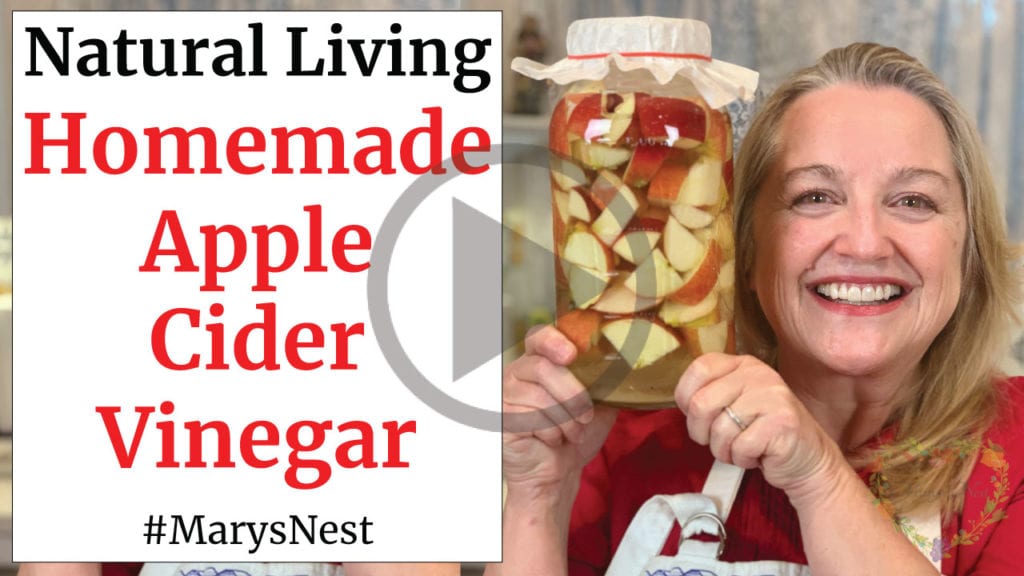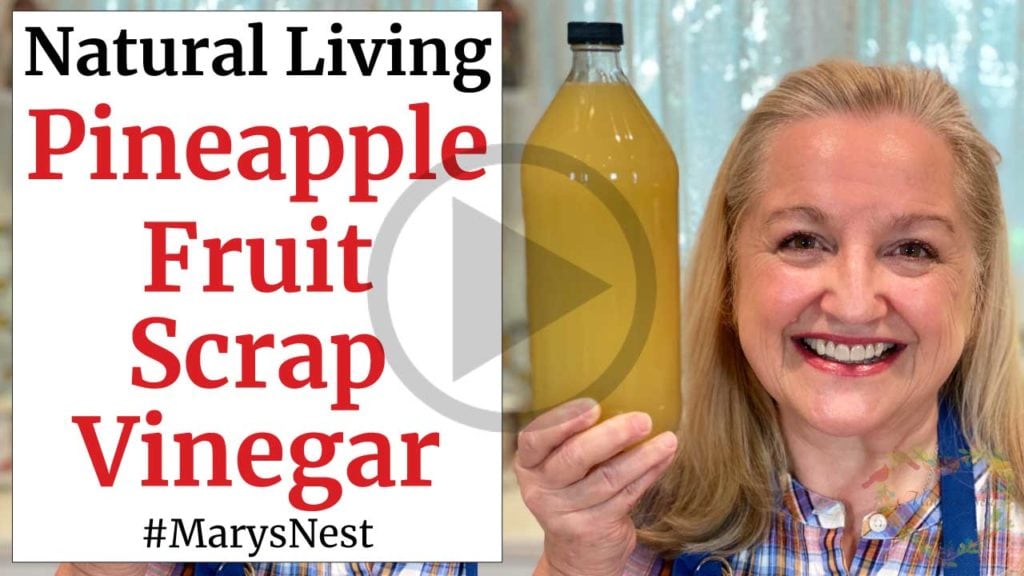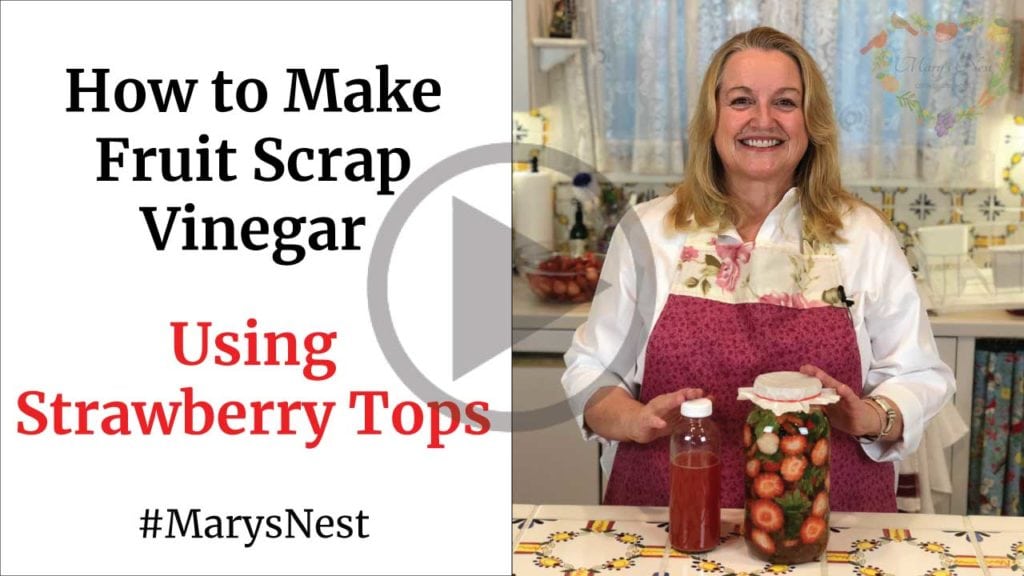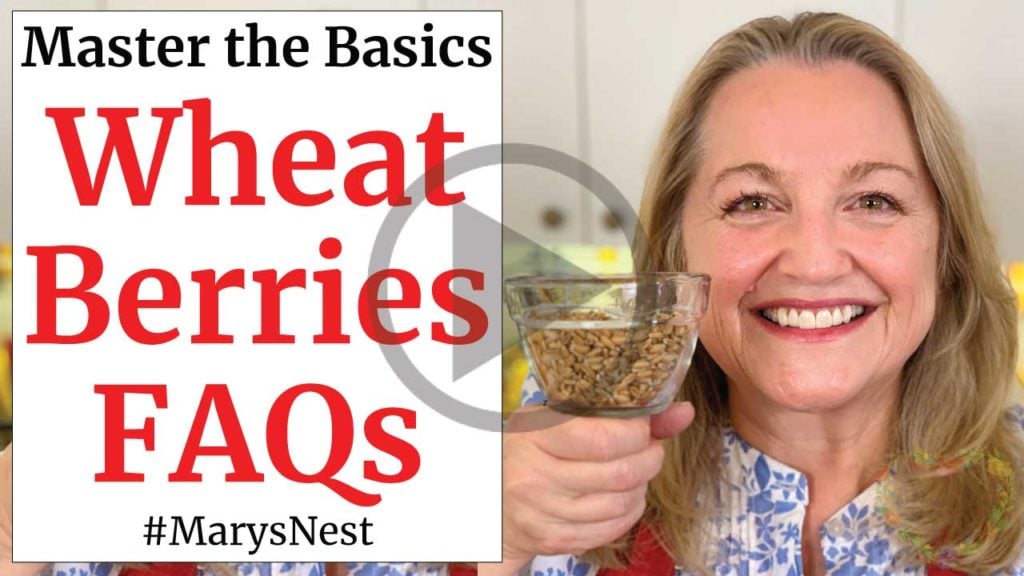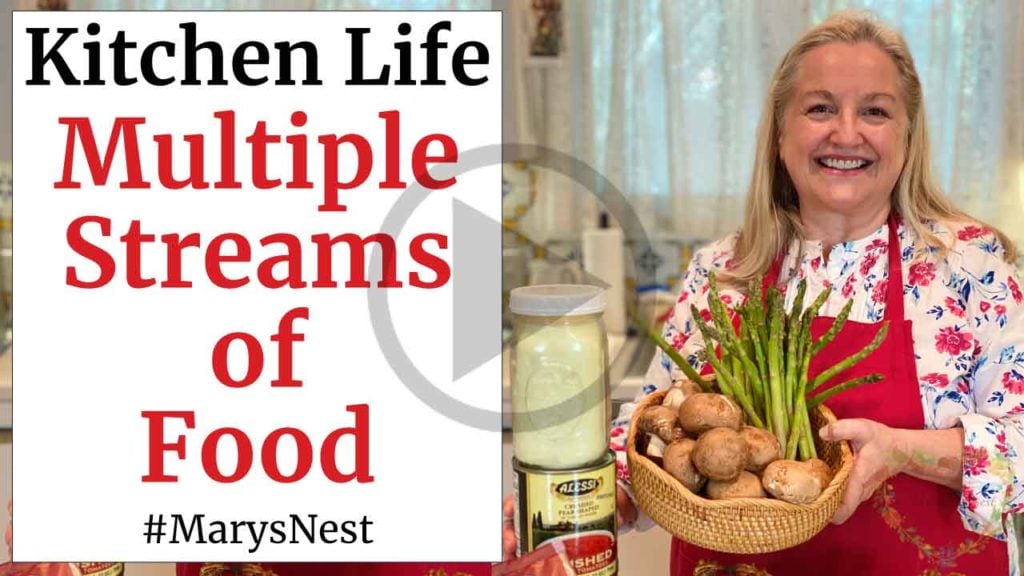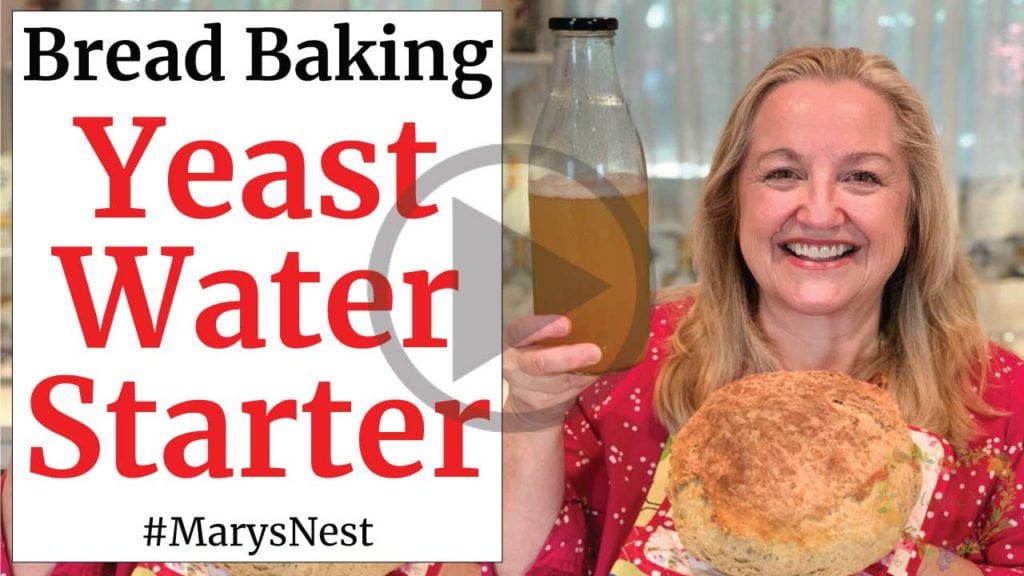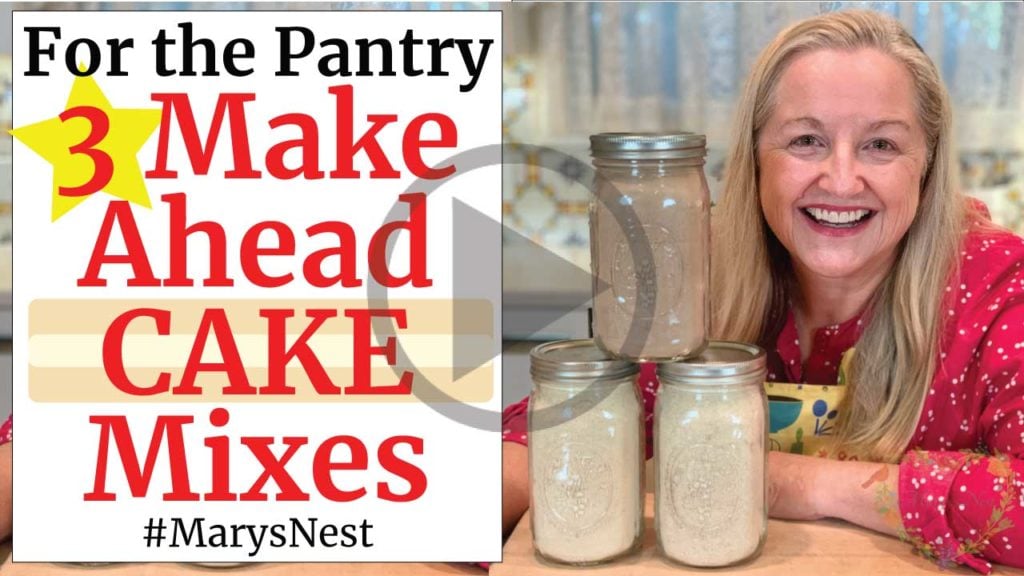Wow! The state of my working pantry reached the point where I had to do something about it. In today’s video, I show you my pantry organization and how I brought order to the disorder in my working pantry. You won’t want to miss my guided tour with before and after pictures.

I’d like to receive more tips and recipes from Mary’s Nest.
Affiliates note: As an Amazon Associate I earn from qualifying purchases. My content may contain affiliate links to products and services. If you click through and make a purchase, I’ll receive a small commission. It does not affect the price you pay.
Table of Contents
- Store-bought or Homemade Vinegar in My Working Pantry?
- Where Is the Flour in My Working Pantry?
- The Amazing Wondra Flour
- The Modern Pioneer Cookbook
- Multiple Streams of Food
- Have a Variety of Food in Your Pantries
- Homemade Powders for Your Working Pantry
- More Homemade Recipes for Your Working Pantry
- Making Recipes from Your Working Pantry
- Download Your Free 36-Page Pantry List
- Join the Traditional Foods Kitchen Academy
- Kitchen Academy Videos
- Shop for items used in this blog post or video
Store-bought or Homemade Vinegar in My Working Pantry?
If you had a choice of storing store-bought vinegar, homemade vinegar, or both in your working pantry, I know what you’d choose. You’d want to have both, and that’s putting multiple streams of food into action!
It’s great to have the convenience and consistency of store-bought food, such as with the organic Apple Cider Vinegar from H-E-B that I store in my working pantry. I know the acidity of the vinegar from my grocery store will be at 5%, and I can use it when I’m preparing recipes where I need to cook the ingredients.
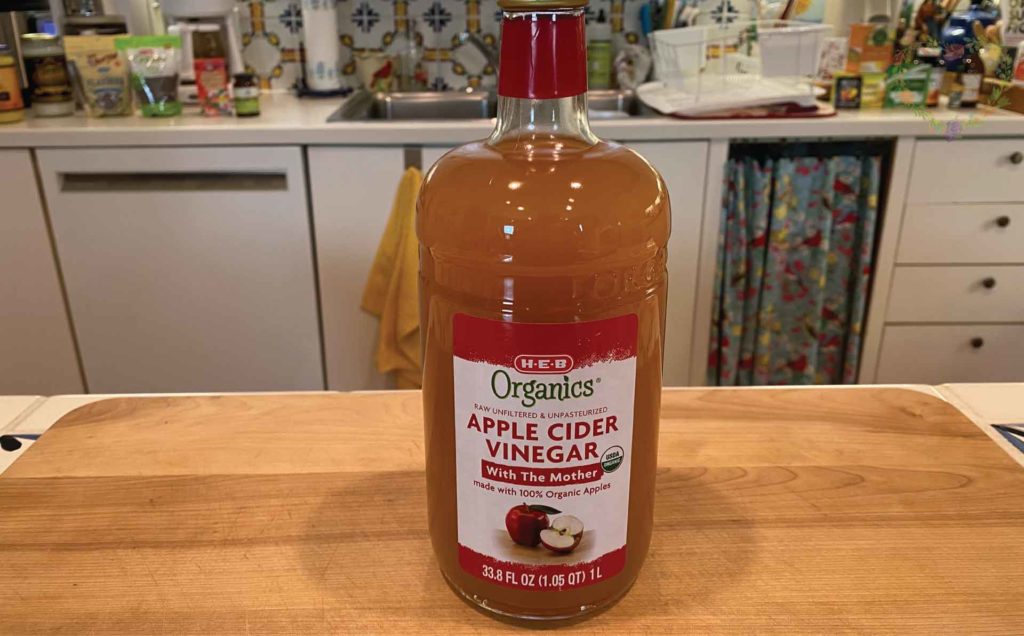
Homemade Vinegars
But what happens if I can’t get to the grocery store or there’s a supply chain problem that prevents the creation of food or shipments to my local supermarket? That’s why I also want homemade vinegar in my working pantry, such as apple cider or fruit scrap vinegar. (As you’ll see in my working pantry tour video, I made homemade Pineapple Vinegar from pineapple fruit scraps.)
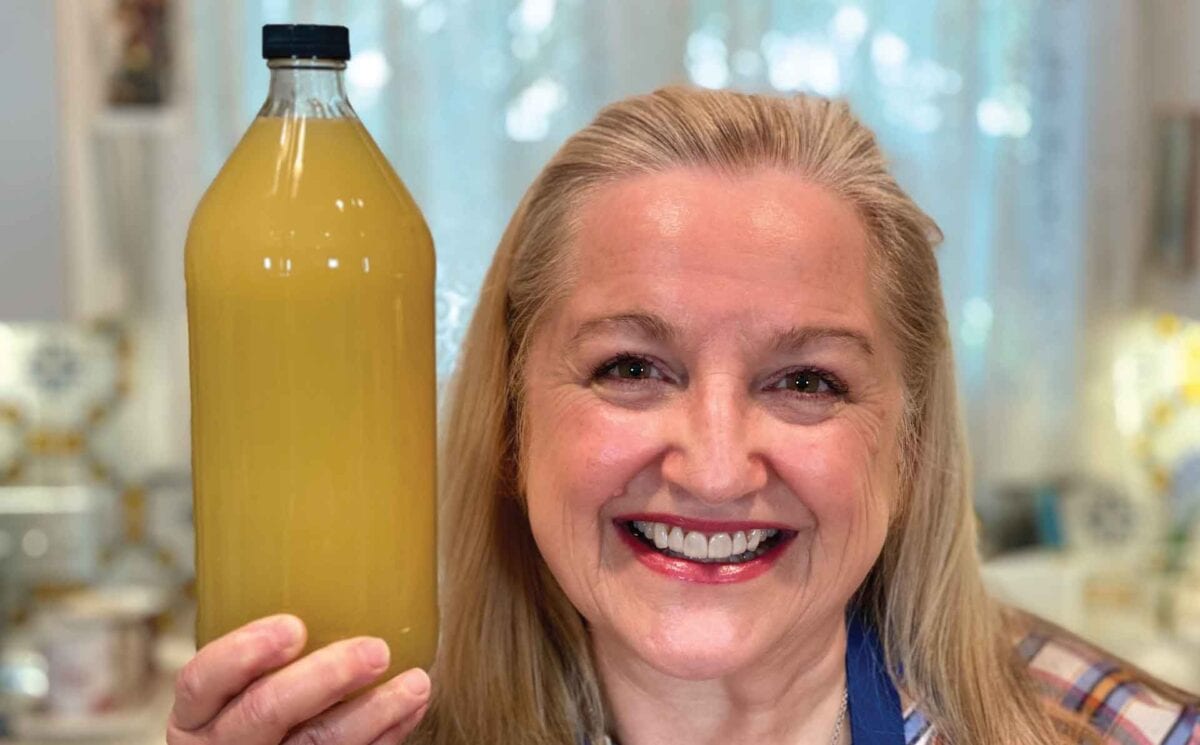
My homemade vinegar can also be healthier than store-bought, since I pick the ingredients and the amount of the “mother” in the vinegar. When I need to select a vinegar to make recipes that I don’t need to heat up, such as salad dressings, I’ll choose from my homemade vinegars instead of the ones I bought from the store.
- Note: You can use pH strips to test the acidity of your homemade vinegar. However, since homemade recipes can vary at different times and in different household conditions, I like to use store-bought vinegar when I need the acidity level to be guaranteed, such as for water bath canning.

Stock a Variety of Vinegars
So the next time you’re at the grocery store, pick up a bottle or two of vinegar for your working pantry. Get a white vinegar and an apple cider vinegar with or without the mother. (I would encourage you to pick the one with the mother even though it may look like sediment to you as you slosh the vinegar bottle around to the curiosity of onlookers)
Next, make your own vinegar, such as an apple cider vinegar or a fruit scrap vinegar. It will take time for the vinegars to develop, so you’ll want to start soon as we go into the autumn season before the temperature drops this winter and vinegar and other fermentation processes begin to slow down.
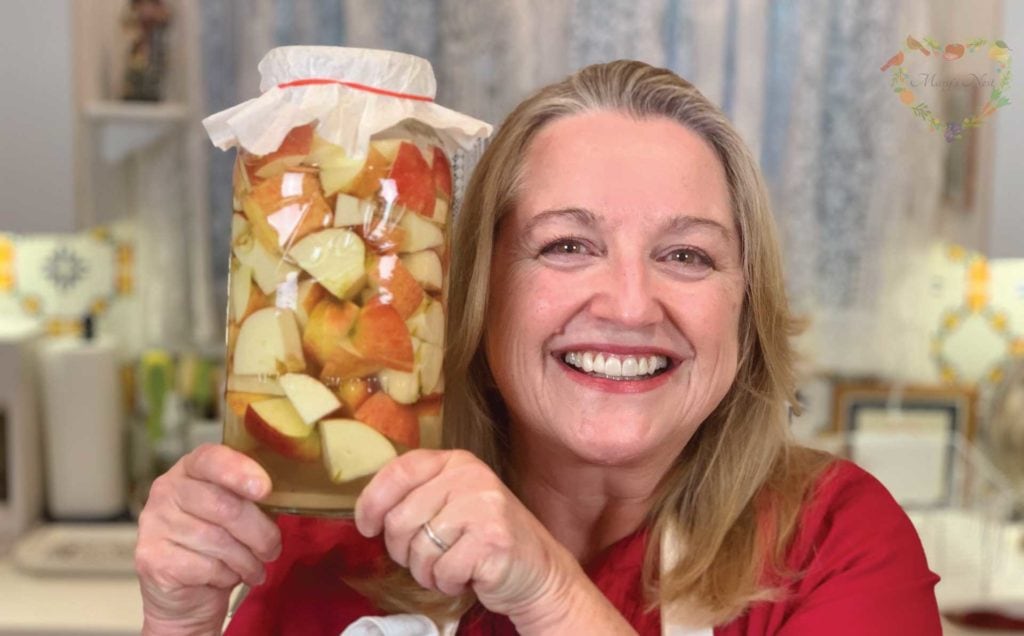
I’ll show you how easy it is to make homemade vinegars in the following videos. If you make at least two different kinds, that’s a bonus you’ll enjoy, as well as give you more variety to choose from for your recipes.
Where Is the Flour in My Working Pantry?
As you watch my pantry organization video, you’ll notice that I don’t have a lot of flour in my working pantry. This is because I store most of my flour in my extended or Prepper Pantry in five-gallon food-safe buckets.
Although I have supplies of flour, I store more whole grains than flour since the whole grains will keep fresh much longer than flour. All-purpose flour typically has a best buy date of a year or two out from when it’s available on your store shelves.
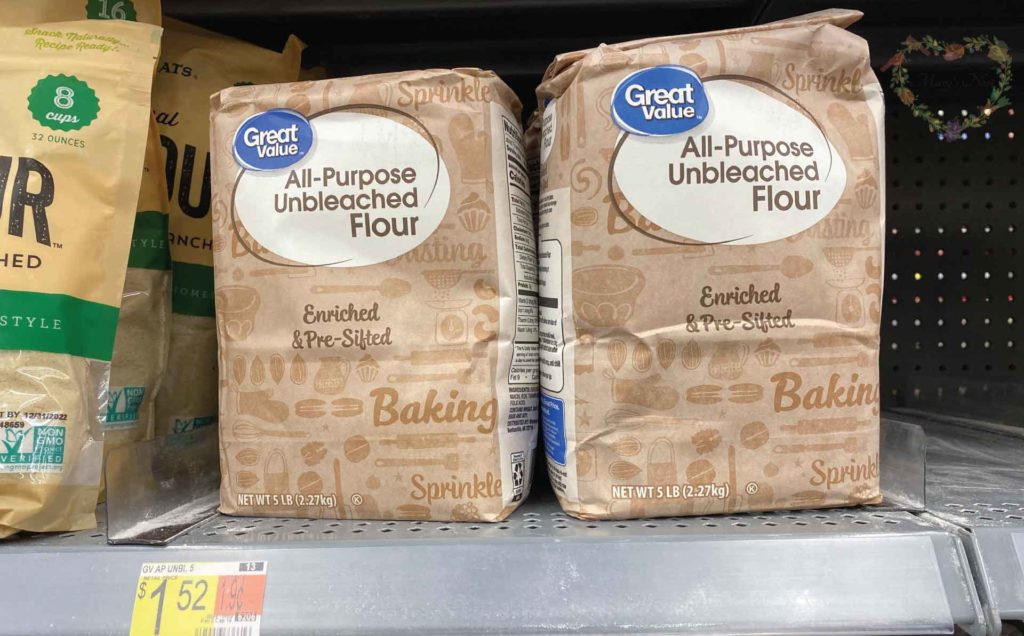
The best buy date for whole grain flour is even shorter. This is because whole grain flour contains the endosperm, the bran, and the germ. The bran and the germ contain oils that go rancid over time, whereas all-purpose flour and bread flour only contain the endosperm. (However, all-purpose and bread flour will also go stale over the long term.)
Storing Whole Grains
In the long run, whole grain is your best bet for long-term storage since, when stored correctly, it can have a shelf life of 10 years or more!
- Note: A whole grain is also called a berry or a groat depending on the particular grain.
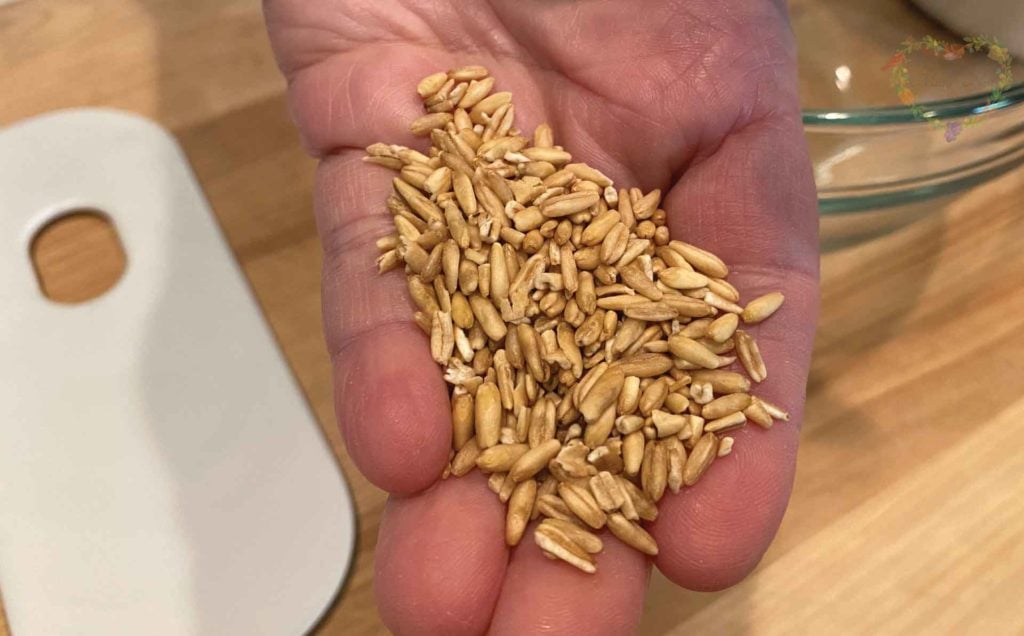
So if you want to have a long-term supply of flour, especially to ensure you have flour in case there’s another disruption in the supply chain, you’ll want to store whole grains. And you can choose from a variety of whole grains, such as Hard Red Wheat or an ancient grain like Einkorn. Watch my Wheat Berries FAQs to learn more about the different whole grains.
If you decide to store whole grains in your Prepper Pantry, you’ll need a grain grinder to turn your whole grains into flour. Fortunately, you can choose from a variety of grain grinders, and like having multiple streams of food, you’ll want to have both a manual and electric grain grinder. I’ll show you how to store your whole grains and make flour in the following video.
Learn more about Mockmill electric grain mills for making fresh flour and their Flake Lover’s Flaker that flakes whole grain in minutes.
- Mockmill 100 Grain Mill unboxing
- Get the Mockmill 100 Stone Grain Mill (Same product I show you my unboxing video.)
- Flake Lover’s Flaker from Mockmill in action (Using this device, you can flake whole grain in minutes.)
The Amazing Wondra Flour
Although I store most of my flour in my Prepper Pantry, I keep some flour handy in my working pantry, and I especially like to keep a glass container with Wondra flour.

Wondra flour was first introduced in 1963, and I remember it quickly making an appearance on my mom’s pantry shelf. This flour is a wheat flour that has been precooked, dried, and ground up fine, making it dissolve quickly in liquids. Wondra flour is my go-to for thickening sauces, and I highly recommend it to be part of the variety of flours you keep on hand.
How to Use Wondra Flour
I love Wondra Flour for making gravies and cheese sauces because since this flour has already been cooked, you do not need to make a roux! In other words, you do not need to worry about cooking the flour with the butter first to remove the raw flour taste.
Instead, everything can go into your saucepan in one fell swoop, and you can literally have a gravy or cheese sauce ready in about one minute! I show you how in the following video.
If you already use Wondra flour, you’ll also notice that I don’t keep the flour in its familiar blue-colored cylinder. You certainly can retain the flour in its original packaging, but I like to empty my containers into a glass container with an airtight seal.
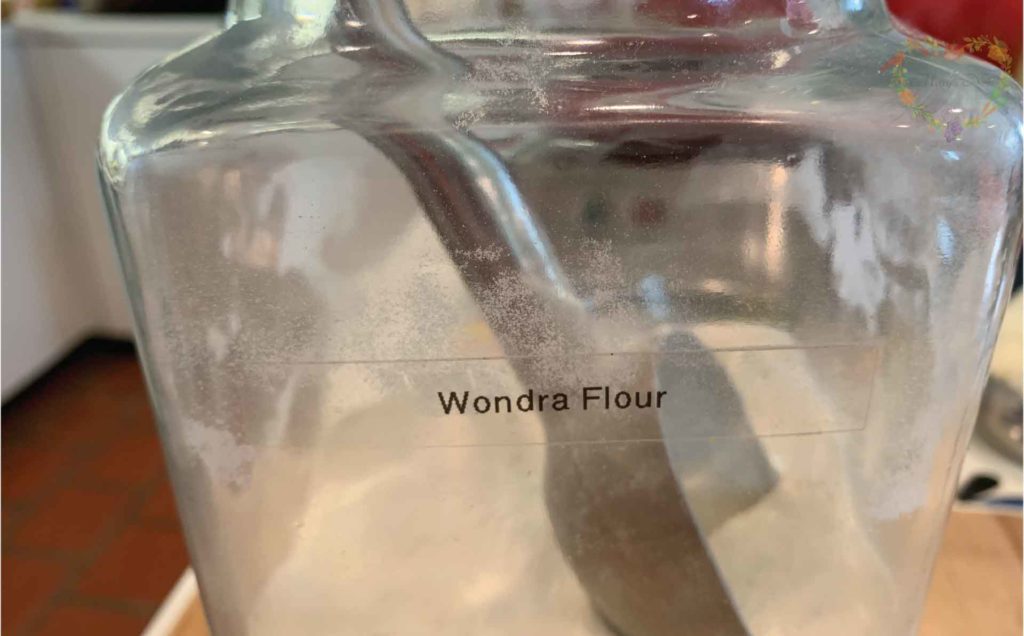
You can rotate the top of the original blue container closed, but it won’t be as tight a seal as a glass container with a gasket. I have a mix of glass containers with loose and tight seals, and if I want to protect the contents of the container against the humidity of central Texas, I’ll choose the ones with tight seals.
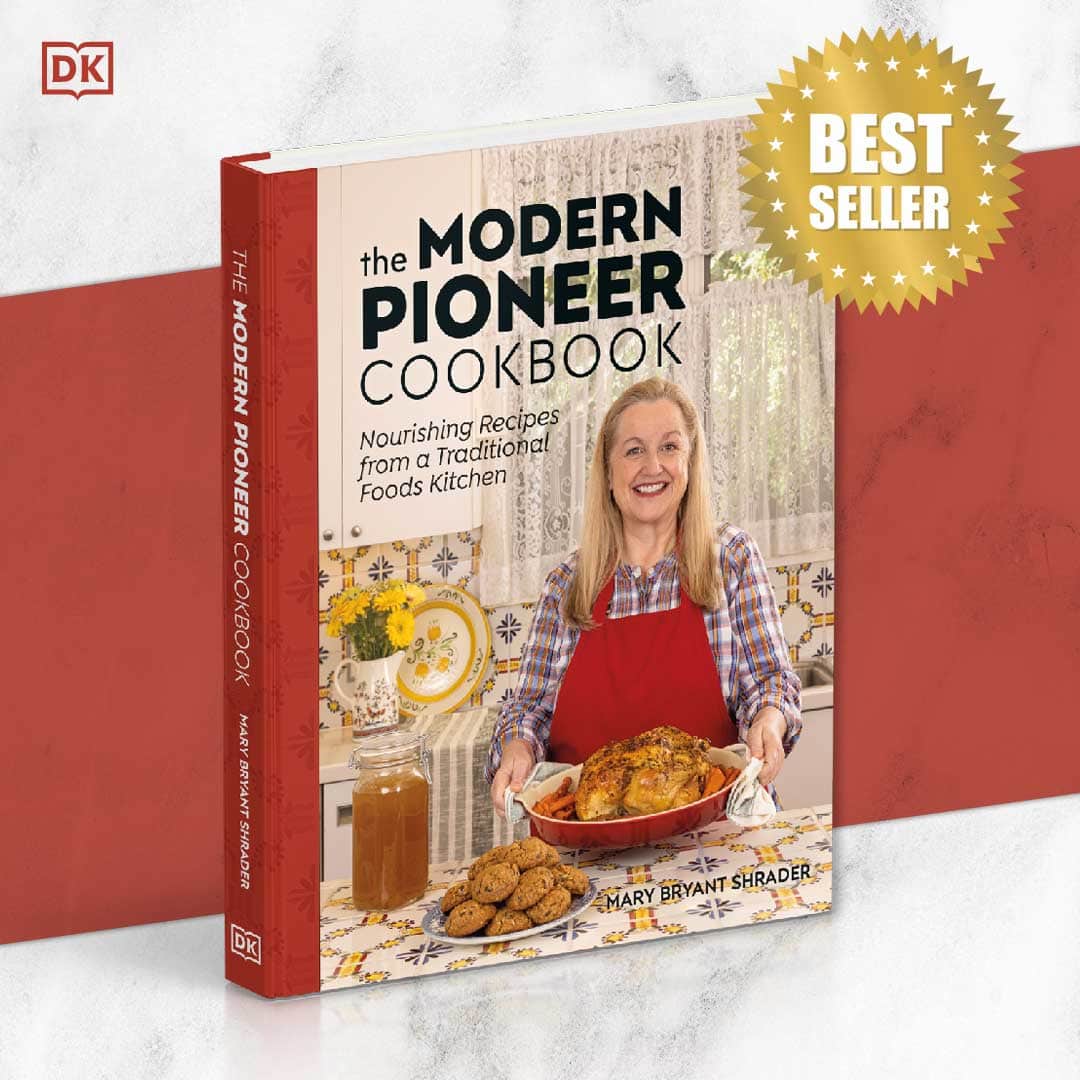
Order YOUR COPY Now!
The Modern Pioneer Cookbook
Seasonal ingredients, traditional techniques, and nourishing recipes. Over 85 traditional, from-scratch recipes! Discover for yourself how you can use simple ingredients and traditional techniques to cook the modern pioneer way.
Multiple Streams of Food
We’ve discussed having a variety of vinegars and flours already. In the case of vinegars, you can purchase some from the store and make some at home. The same is true with flours. You can buy flour from your grocery store, but you can also grind fresh flour from the whole wheat berries you store in your Prepper Pantry.
Make sure you have these multiple streams of food you can rely upon for your four corners pantry. Then, in case an emergency or unexpected event occurs and one of the streams dries up (such as with the absence of flour on store shelves in 2020), you’ll still be able to draw from another stream to make meals for yourself and your family.
Having multiple streams of food also helps to fight food inflation. I talk about all the benefits in the following video.
And remember when we couldn’t get yeast either? The good news is you can make your own yeast, and I show you how in my yeast water and yeast water bread video.
If you want to learn how to create your own sourdough starter and never have to worry about buying packaged yeast again, I show you how through my step-by-step complete sourdough starter guide video that makes the whole process very easy.
Have a Variety of Food in Your Pantries
It’s not only essential to have multiple streams of food filling up your four corners pantry, but you also want to have a variety of food in those streams.
In last week’s video, I talked about the 7 food storage mistakes people make and how to avoid them. One of the mistakes is not having enough variety of food, which can lead to problems with limited recipes, difficulties with food digestion, or the development of food intolerances.
But having a variety of food is easy to remedy. As we already discussed and I show you in my tour video, I have multiple streams of vinegar (store-bought and homemade) and various types of vinegars (apple cider, fruit scrap, and white).
Homemade Powders for Your Working Pantry
You’ll see two homemade powders in my working pantry:
- Tomato Powder – Create this delightfully tasting powder in your oven or dehydrator and use it for seasonings, soups, juices, or dry rubs.
- Electrolyte Drink Powder – Make this refreshing sports drink or elegant spa water with a splendid blend of minerals that will balance the electrolytes in your body.
Both are easy to make and have an excellent shelf life in your working pantry.
More Homemade Recipes for Your Working Pantry
To help stock your working pantry with homemade items, try making the following extract and shelf-stable cake mixes.
You’ve seen my homemade vanilla extract in several of my video recipes. It’s so easy to make, but it takes time for the ingredients to steep. So get the ingredients, follow my vanilla extract recipe, and let time and your working pantry shelf do all the work. You’ll never have to worry about how much inflation has increased the price of this ingredient from the grocery store again!
Make-Ahead Mixes
My make-ahead series continues to be popular as folks look for shelf-stable mixes they can create ahead of time and store in their working pantries. I’ve covered healthy make-ahead mixes for everything from pancakes to cookies and a cream of soup mix. You can choose to make any of the mixes that you’d enjoy creating recipes for in the coming months.
In my tour video, I talk about the different cake mixes you can make, so you can bake up a chocolate, yellow, or spice cake in no time!
Making Recipes from Your Working Pantry
Are there a variety of meals I can make from the ingredients in my working pantry? You bet! Here are just a few examples.
Those handy packages of Fideo I bought for 28 cents during my recent grocery haul at Aldi’s found a home in my working pantry. They’ll come in handy the next time I make homemade Rice-A-Roni.
And I’ll be able to use the cans of cannellini beans along with some greens from my refrigerator (also part of my four corners pantry!) to make a delicious beans and greens soup. With the cooler months coming up later this year, you’re going to love this flavorful soup.
Download Your Free 36-Page Pantry List
For an extensive list of the traditional foods you can make and purchase to stock your pantry, be sure to download my free 36-page Traditional Foods Pantry List. This comprehensive eBook is full of links to recipe videos, helpful articles, and more!
My pantry list covers your Four Corners Pantry, which consists of your:
- Working Pantry – What you access every day. (I show you my working pantry in today’s video.)
- Refrigerator
- Freezer
- Extended or Prepper Pantry
How to Create a Prepper Pantry
If you’re new to the concept of a Prepper Pantry, watch the following videos that will help you build a Prepper Pantry over time and on a budget or on an accelerated basis if you need to get it stocked sooner rather than later.
Join the Traditional Foods Kitchen Academy
Are you looking for more traditional foods videos? If so, I invite you to join the Traditional Foods Kitchen Academy. Members of this optional paid YouTube community get access to exclusive videos, live streams, and other members-only perks. Plus, your YouTube comments include a special members-only badge.
In the following members-only videos, you can tour my kitchen where I cook and film videos and go behind the scenes for the filming of my working pantry video.
Kitchen Academy Videos
Discussing the Secrets to Perfect Green Herbal Oils
Let’s talk about the popularity of flavored herbal oils.
Are You Salt Sensitive or Salt Resistant? Get the Latest Salt Intake Research
Learn how your body may react to salt intake differently from others.
What Is the Best Time to Eat Dinner?
Find out if eating dinner early or late is best for you. You might be surprised!
Stay in Touch with Mary’s Nest
- Subscribe to My YouTube Channel for Traditional Foods Videos (Free) - When you subscribe, be sure to click on the notification bell that will let you know each time I upload a new video.
- Subscribe to Mary’s Traditional Foods Newsletter (Free) - Get a free 36-page eBook for signing up: How to Stock Your Essential Traditional Foods Four-Corners Pantry.
- Join the Traditional Foods Kitchen Academy (Optional Paid) - For more detailed videos and exclusive members-only perks, join my YouTube membership community.
- Order The Modern Pioneer Cookbook (Optional Paid) - Get a printed book of Mary's nourishing recipes from a Traditional Foods Kitchen. This bestselling cookbook is published by Penguin Random House with their DK imprint.
I look forward to having you join me in my Texas Hill Country Kitchen!
Shop for items used in this blog post or video
Favorite Pantry Organization Supplies
Note: I recommend using this pantry organization list only as a guide. You may be able to find these products at your local kitchen or big box stores because they have become very expensive online.
- Large Square Jars
- Round Heritage Jars
- Open Top Plastic Bins
- Bamboo Lidded Bins
- Large Plastic Lidded Bins
- Small Plastic Lidded Bins
- Expandable Tiered Shelf
- 2-Tier Pull-Out Wire Baskets
- Wire Shelf (on the floor in my pantry)
- Pantry Door Rack
Favorite Kitchen Supplies
- Favorite Aprons
- Spice Grinder
- Countertop Burner (On my kitchen island in many recipe videos.)
- Handheld Vacuum Sealing System
- Vacuum Lids
- Whisk
- Silica Gel Packets (Helps keep moisture from building up in your mix)
- Cast Iron Dutch Oven
- 8-Quart Slow-Cooker
- Fat Separator (Clever kitchen device to help you decant bone broth)
- Flour Sack Towels
- pH Strips (Helps you check on the acidity of your vinegar)
Amazon Shop and Shopping Guide
- Visit Mary’s Nest Amazon Shop
- Visit my Shopping Guide page
Get up to 15% off for stocking your Traditional Foods Pantry and equipping your Modern Pioneer Kitchen, including discounts from US Wellness Meats, Farmhouse Teas, Lehman's, Masontops, Cultures for Health, Survival Garden Seeds, Redmond Real Salt, Plan to Eat, and More!
